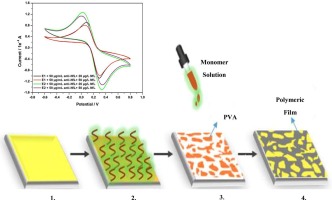Materials Science and Engineering: B ( IF 3.9 ) Pub Date : 2020-04-13 , DOI: 10.1016/j.mseb.2020.114545 Erdoğan Özgür , Handan Uzunçakmak Uyanık , Serap Şenel , Lokman Uzun

|
Neurofilament light chain (NfL) has been classified as one of the most prominent biomarkers for identification of Parkinson's disease that is manifested by loss of dopaminergic neurons in the gray matter of the brain with the formation of cytoplasmic inclusion bodies in the brain tissue. Novel biosensors are needed for diagnosis of Parkinson's disease as well as monitoring of the treatment process. So, the concentration of NfL in cerebrospinal fluid has been reported to be useful in distinguishing Parkinson's disease from atypical Parkinson's syndromes. For this purpose, an electrochemical immunoaffinity biosensor having limit of detection (LOD), and limit of quantitation (LOQ) as 5.21 ng/L and 15.79 ng/L has been developed for the determination of NfL concentration. In this study, glycidyl methacrylate (GMA) functional monomer was used to form thin polymeric films on the electrode surface and the anti-NfL antibody was immobilized via covalent linkage with GMA as a biorecognition agent.
中文翻译:

用于神经丝轻链检测的免疫亲和生物传感器及其在帕金森氏症诊断中的应用
神经丝轻链(NfL)已被列为帕金森氏病最重要的生物标志物之一,其表现为脑灰质中多巴胺能神经元的丧失,并在脑组织中形成了胞质包涵体。需要新型生物传感器来诊断帕金森氏病以及监测治疗过程。因此,据报道脑脊液中NfL的浓度可用于区分帕金森氏病和非典型帕金森氏综合症。为此目的,已经开发出具有检测极限(LOD)和定量极限(LOQ)为5.21ng / L和15.79ng / L的电化学免疫亲和生物传感器用于测定NfL浓度。在这个研究中,











































 京公网安备 11010802027423号
京公网安备 11010802027423号